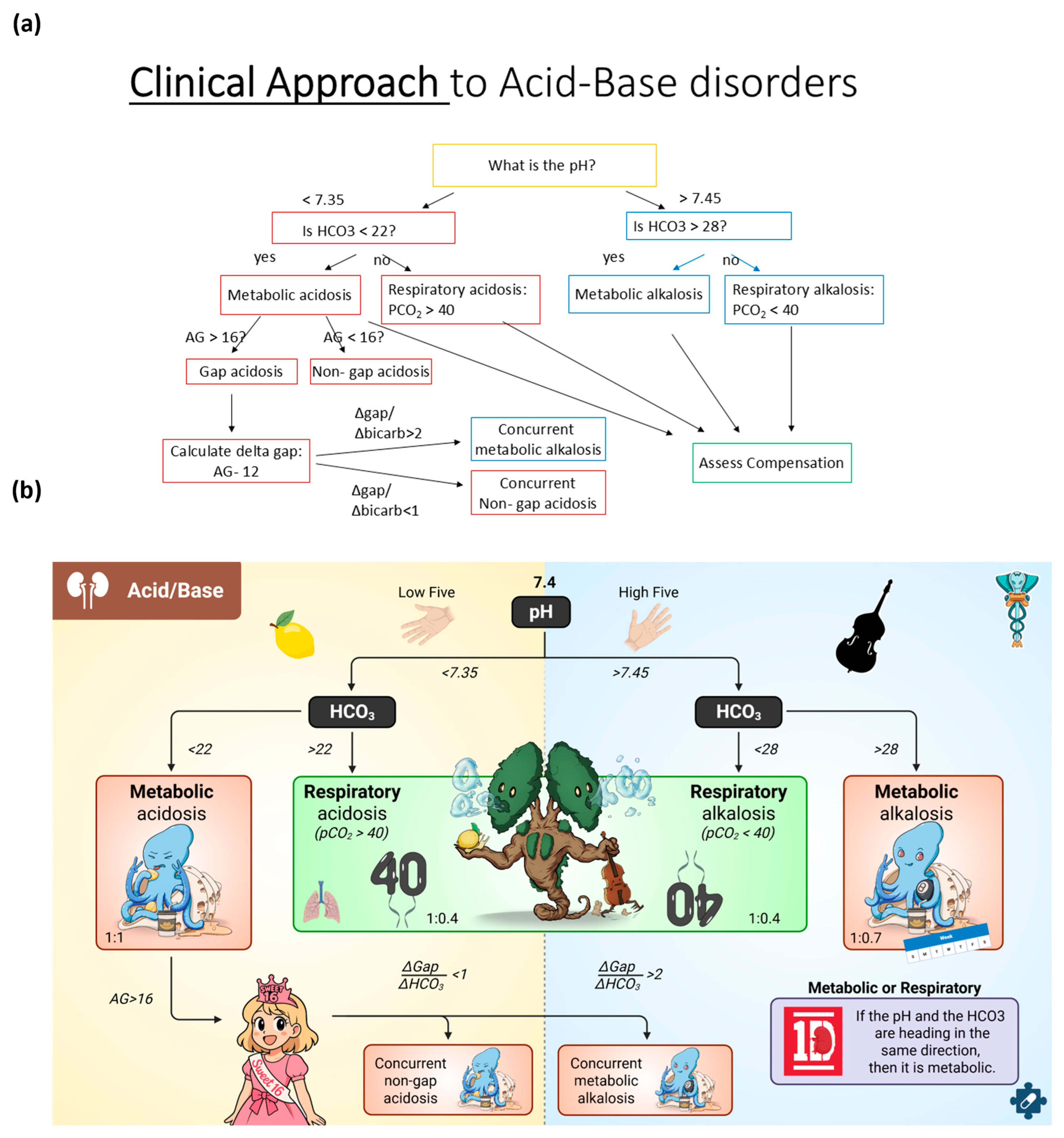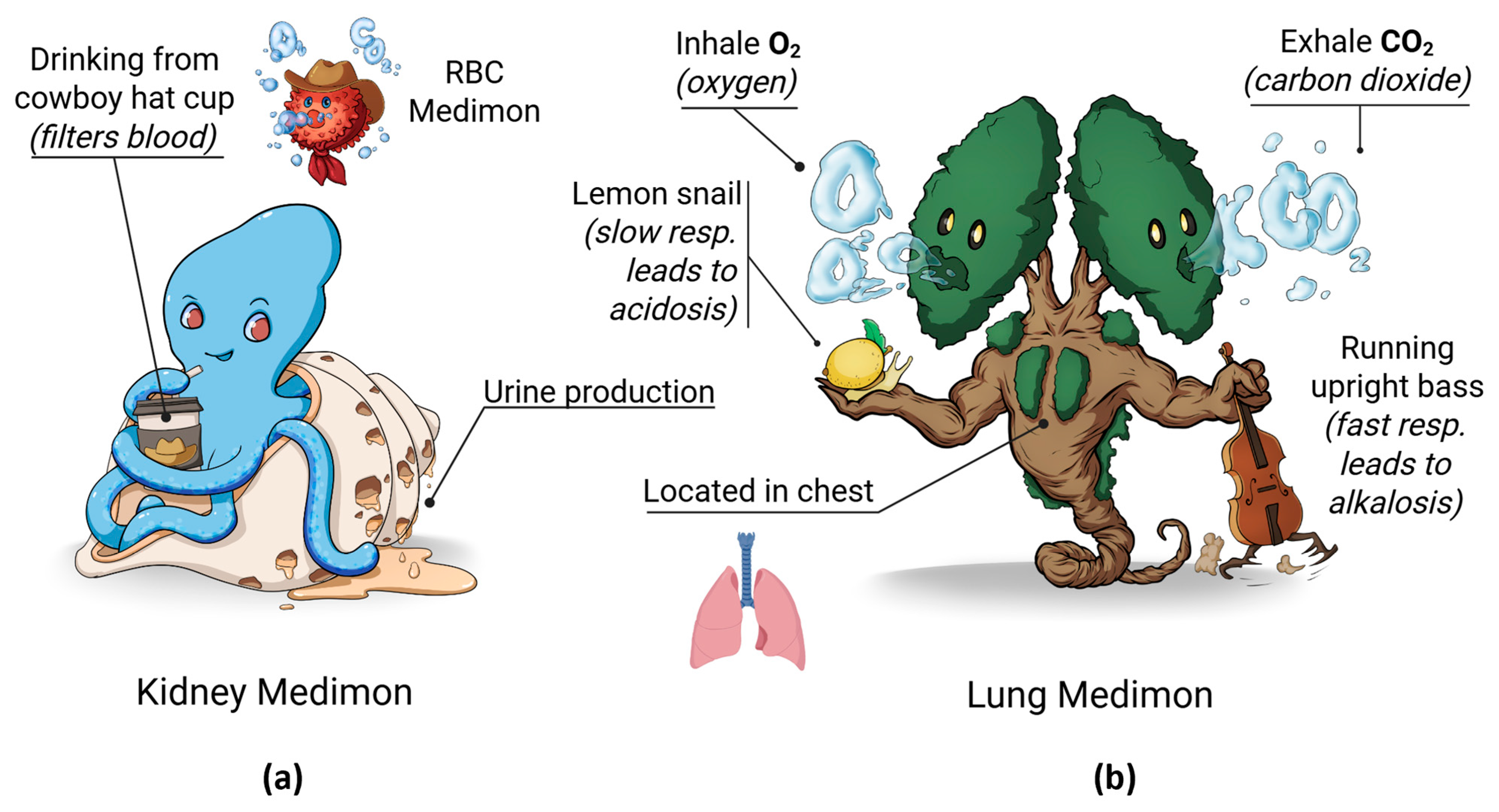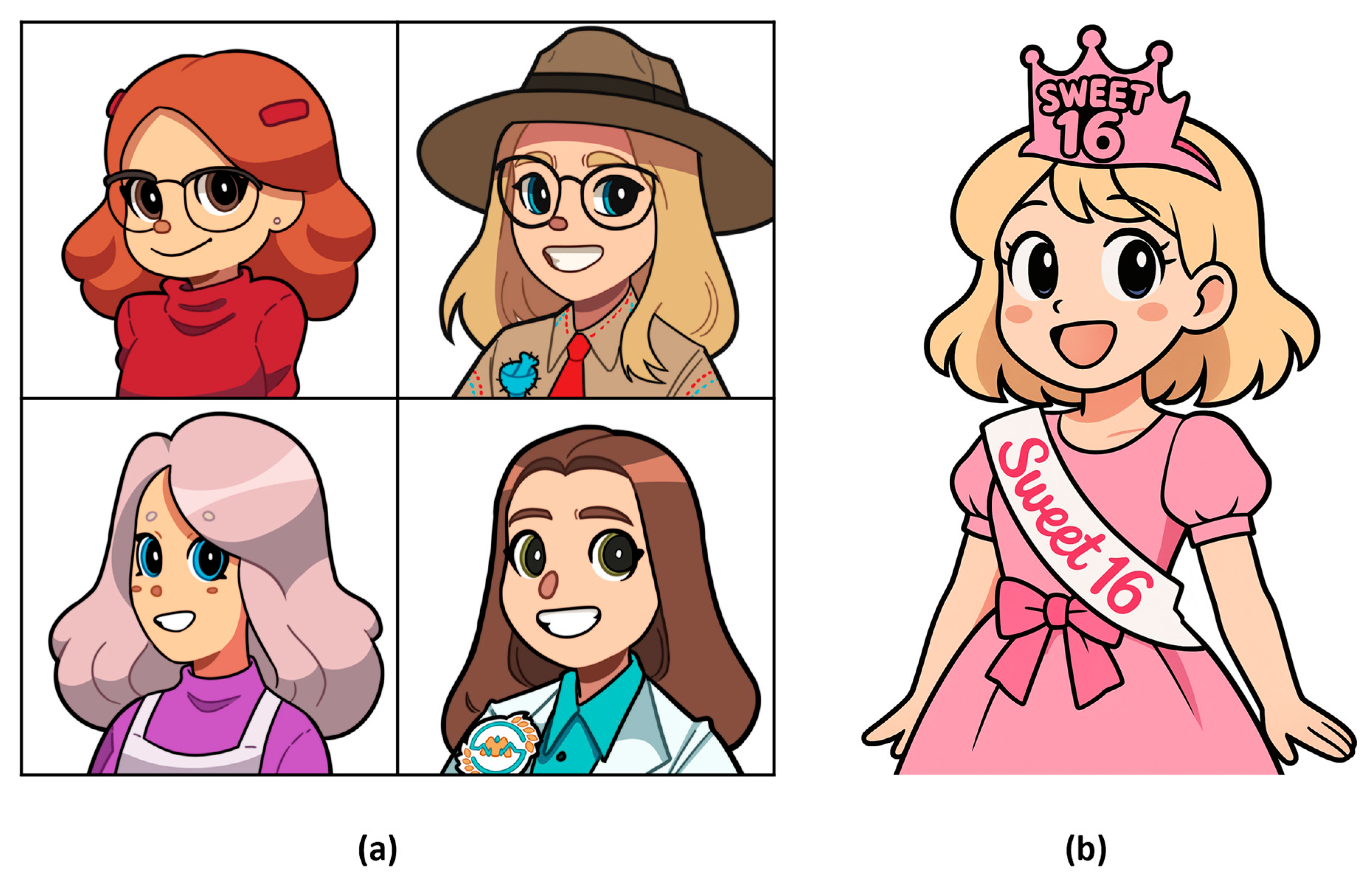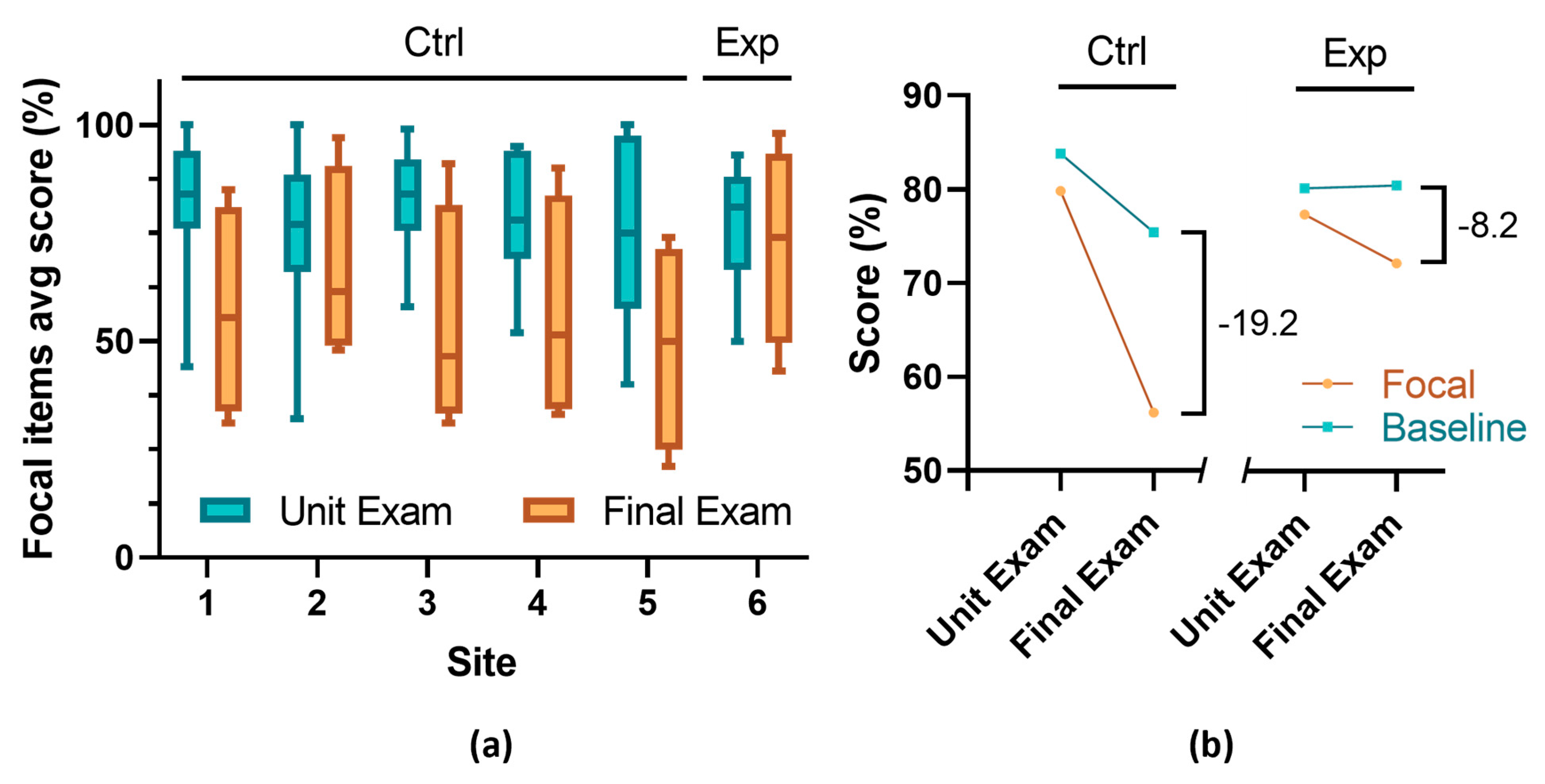A Multi-Institution Mixed Methods Analysis of a Novel Acid-Base Mnemonic Algorithm
Abstract
1. Introduction
2. Materials and Methods
2.1. Participants
2.2. Intervention
2.2.1. Medimon
2.2.2. AI Image Generation
2.2.3. Mnemonic Integration
2.3. Assessments
2.4. Data Collection
2.5. Data Analysis
2.5.1. Achievement
2.5.2. SIS-M Quantitative
2.5.3. SIS-M Thematic Analysis
- Planning (PI Agent): The Principal Investigator (PI) agent analyzed the full set of survey responses and the draft manuscript. Based on this input, the agent produced a detailed, stepwise plan for conducting the thematic analysis.
- Initial Coding (QR Agents): The plan was independently executed by two Qualitative Researcher (QR) agents. Each QR agent performed initial coding of all survey responses, generating codebooks that reflected distinct interpretive perspectives.
- Code Review (PI Agent): The PI agent reviewed the two independent codebooks, identifying overlapping codes, resolving disagreements, and refining the code structure to maintain coherence and analytic rigor.
- Theme Generation (QR Agents): The revised coding framework was then passed to two additional QR agents, who independently organized the codes into higher-order categories and articulated candidate themes.
- Synthesis (PI Agent): The two independent thematic analyses were reconciled by the PI agent, who synthesized them into a single cohesive set of themes, ensuring that all salient ideas from the student responses were represented.
2.6. Ethical Considerations
3. Results
3.1. Achievement
3.2. SIS-M Quantitative
3.3. Thematic Analysis
4. Discussion
5. Conclusions
Supplementary Materials
Author Contributions
Funding
Institutional Review Board Statement
Informed Consent Statement
Data Availability Statement
Acknowledgments
Conflicts of Interest
Abbreviations
| MS1/MS2 | First-year medical student/Second-year medical student |
| NPC | Non-playable character |
| MCQ | Multiple-choice question |
| SIS-M | Situational Interest Survey for Multimedia |
| Trig | Triggered situational interest |
| MF | Maintained-feeling situational interest |
| MV | Maintained-value situational interest |
| MT | Maintained total situational interest |
| DiD | Differences-in-Differences |
| LLM | Large Language Model |
| genAI | Generative Artificial Intelligence |
Appendix A
| SIS Type | Survey Item |
|---|---|
| SI-triggered | The X algorithm was interesting. |
| The X algorithm grabbed my attention. | |
| The X algorithm was often entertaining. | |
| The X algorithm was so exciting, it was easy to pay attention. | |
| SI-maintained-feeling | What I learned from the X algorithm is fascinating to me. |
| I am excited about what I learned from the X algorithm. | |
| I like what I learned from the X algorithm. | |
| I found the information from the X algorithm interesting. | |
| SI-maintained-value | What I studied in the X algorithm is useful for me to know. |
| The things I studied in the X algorithm are important to me. | |
| What I learned from the X algorithm can be applied to my major/career. | |
| I learned valuable things from the X algorithm. |
| Site | Focal Items % (SD) | Baseline Items % (SD) | Within-Site Gap (F − B *, %) | DiD (ES − Ctrl, %) | t | p (Two-Tailed) |
|---|---|---|---|---|---|---|
| ES | 77.4 (14.6) | 80.2 (13.7) | −2.8 | |||
| 1 | 82.2 (16.9) | 86.7 (13.0) | −4.5 | 1.7 | 0.51 | 0.612 |
| 2 | 74.8 (19.9) | 86.2 (13.2) | −11.4 | 8.6 | 1.65 | 0.119 |
| 3 | 81.9 (12.3) | 82.8 (10.4) | −0.9 | −1.9 | −0.54 | 0.598 |
| 4 | 79.2 (14.5) | 83.7 (12.0) | −4.5 | 1.7 | 0.60 | 0.558 |
| 5 | 76.7 (21.5) | 82.0 (15.9) | −5.3 | 2.5 | 0.43 | 0.670 |
| 1–5 (pooled) | 79.8 (14.5) | 83.8 (10.5) | −4.0 | 1.2 | 0.38 | 0.707 |
| Site | Focal Items % (SD) | Baseline Items % (SD) | Within-Site Gap (F − B *, %) | DiD (ES − Ctrl, %) | t | p (Two-Tailed) |
|---|---|---|---|---|---|---|
| ES | 72.3 (22.9) | 80.5 (20.1) | −8.2 | |||
| 1 | 56.8 (24.7) | 75.0 (21.1) | −18.2 | 10.0 | 1.26 | 0.289 |
| 2 | 67.0 (22.4) | 76.0 (16.7) | −9.0 | 0.8 | 0.15 | 0.889 |
| 3 | 53.8 (26.4) | 75.0 (16.7) | −21.2 | 13.0 | 1.26 | 0.293 |
| 4 | 56.5 (26.4) | 76.1 (17.4) | −19.6 | 11.4 | 1.32 | 0.274 |
| 5 | 48.8 (24.1) | 74.9 (18.4) | −26.2 | 17.9 | 1.44 | 0.240 |
| 1–5 (pooled) | 56.2 (24.2) | 75.4 (16.6) | −19.2 | 11.0 | 1.32 | 0.272 |
References
- Roberts, J.K.; Sparks, M.A.; Lehrich, R.W. Medical Student Attitudes towards Kidney Physiology and Nephrology: A Qualitative Study. Ren. Fail. 2016, 38, 1683. [Google Scholar] [CrossRef]
- Richardson, D.; Speck, D. Addressing students’ misconceptions of renal clearance. Adv. Physiol. Educ. 2004, 28, 210–212. [Google Scholar] [CrossRef]
- Hull, W.; Jewell, E.; Shabir, S.; Borrows, R. Nephrophobia: A retrospective study of medical students’ attitudes towards nephrology education. BMC Med. Educ. 2022, 22, 667. [Google Scholar] [CrossRef] [PubMed]
- Leehey, D.J.; Daugirdas, J.T. Teaching renal physiology in the 21st century: Focus on acid-base physiology. Clin. Kidney J. 2016, 9, 330–333. [Google Scholar] [CrossRef] [PubMed]
- Petersen, C.I.; Baepler, P.; Beitz, A.; Ching, P.; Gorman, K.S.; Neudauer, C.L.; Rozaitis, W.; Walker, J.D.; Wingert, D. The Tyranny of Content: “Content Coverage” as a Barrier to Evidence-Based Teaching Approaches and Ways to Overcome It. CBE—Life Sci. Educ. 2020, 19, ar17. [Google Scholar] [CrossRef]
- Evans, P.; Vansteenkiste, M.; Parker, P.; Kingsford-Smith, A.; Zhou, S. Cognitive Load Theory and Its Relationships with Motivation: A Self-Determination Theory Perspective. Educ. Psychol. Rev. 2024, 36, 7. [Google Scholar] [CrossRef]
- Besche, H.C.; King, R.W.; Shafer, K.M.; Fleet, S.E.; Charles, J.F.; Kaplan, T.B.; Greenzang, K.A.; Hoenig, M.P.; Schwartzstein, R.M.; Cockrill, B.A.; et al. Effective and Engaging Active Learning in the Medical School Classroom: Lessons from Case-Based Collaborative Learning. J. Med. Educ. Curric. Dev. 2025, 12, 23821205251317148. [Google Scholar] [CrossRef]
- Tackett, S.; Steinert, Y.; Whitehead, C.R.; Reed, D.A.; Wright, S.M. Blind spots in medical education: How can we envision new possibilities? Perspect. Med. Educ. 2022, 11, 365. [Google Scholar] [CrossRef]
- Lyra, K.T.; Isotani, S.; Reis, R.C.D.; Marques, L.B.; Pedro, L.Z.; Jaques, P.A.; Bitencourt, I.I. Infographics or Graphics+Text: Which material is best for robust learning? In Proceedings of the IEEE 16th International Conference on Advanced Learning Technologies, ICALT, Austin, TX, USA, 25–28 July 2016; pp. 366–370. [Google Scholar]
- Sweller, J. Cognitive load theory, learning difficulty, and instructional design. Learn. Instr. 1994, 4, 295–312. [Google Scholar] [CrossRef]
- Young, J.Q.; Van Merrienboer, J.; Durning, S.; Ten Cate, O. Cognitive Load Theory: Implications for medical education: AMEE Guide No. 86. Med. Teach. 2014, 36, 371–384. [Google Scholar] [CrossRef] [PubMed]
- Haghani, F.; Ghanbari, S.; Barekatain, M.; Jamali, A. A systematized review of cognitive load theory in health sciences education and a perspective from cognitive neuroscience. J. Educ. Health Promot. 2020, 9, 176. [Google Scholar] [CrossRef] [PubMed]
- Cowan, N. The magical number 4 in short-term memory: A reconsideration of mental storage capacity. Behav. Brain Sci. 2001, 24, 87–114. [Google Scholar] [CrossRef] [PubMed]
- Morikawa, M.J.; Ganesh, P.R. Acid-Base Interpretation: A Practical Approach. Am. Fam. Physician 2025, 111, 148–155. [Google Scholar]
- Margolis, C.Z. Uses of Clinical Algorithms. JAMA 1983, 249, 627–632. [Google Scholar] [CrossRef]
- Zimmermann, A.E.; King, E.E.; Bose, D.D. Effectiveness and Utility of Flowcharts on Learning in a Classroom Setting: A Mixed-Methods Study. Am. J. Pharm. Educ. 2024, 88, 100591. [Google Scholar] [CrossRef] [PubMed]
- Meenu, S.; Zachariah, A.M.; Balakrishnan, S. Effectiveness of mnemonics based teaching in medical education. Int. J. Health Sci. 2022, 6, 9635–9640. [Google Scholar] [CrossRef]
- Abdalla, M.M.I.; Azzani, M.; Rajendren, R.; Hong, T.K.; Balachandran, Y.; Hassan, T.R.; Wei, T.Y.; Yahaya, U.K.B.; En, L.J.; Ajaykumar, S.; et al. Effect of Story-Based Audiovisual Mnemonics in Comparison with Text-Reading Method on Memory Consolidation Among Medical Students: A Randomized Controlled Trial: Story-based audiovisual mnemonics and memory retention. Am. J. Med. Sci. 2021, 362, 612–618. [Google Scholar] [CrossRef]
- Hurst, N.B.; Grossart, E.A.; Knapp, S.; Stolz, U.; Groke, S.F.; Solem, C.R.; Williams, A.; French, R.N.; Appel, J.E.; Walter, F.G. Do mnemonics help healthcare professionals learn and recall cholinergic toxidromes? Clin. Toxicol. 2022, 60, 860–862. [Google Scholar] [CrossRef]
- Clark, J.M.; Paivio, A. Dual coding theory and education. Educ. Psychol. Rev. 1991, 3, 149–210. [Google Scholar] [CrossRef]
- Smith, B.; Shimeld, S. Using pictorial mnemonics in the learning of tax: A cognitive load perspective. High. Educ. Res. Dev. 2014, 33, 565–579. [Google Scholar] [CrossRef]
- Grover, S.; Pea, R. Computational Thinking in K–12. Educ. Res. 2013, 42, 38–43. [Google Scholar] [CrossRef]
- Avila-Pesántez, D.; Rivera, L.A.; Alban, M.S. Approaches for serious game design: A systematic literature review. Comput. Educ. J. 2017, 8, 1–11. [Google Scholar]
- Fung, K.; Oyibo, K. Examining the Effectiveness of Mnemonics Serious Games in Enhancing Memory and Learning: A Scoping Review. Appl. Sci. 2024, 14, 11379. [Google Scholar] [CrossRef]
- Bellotti, F.; Kapralos, B.; Lee, K.; Moreno-Ger, P.; Berta, R. Assessment in and of serious games: An overview. Adv. Hum.-Comput. Interact. 2013, 2013, 136864. [Google Scholar] [CrossRef]
- Edwards, S.L.B.; Zarandi, A.; Cosimini, M.; Chan, T.M.M.; Abudukebier, M.; Stiver, M.L. Analog Serious Games for Medical Education: A Scoping Review. Acad. Med. 2024, 100, 375–387. [Google Scholar] [CrossRef] [PubMed]
- Haoran, G.; Bazakidi, E.; Zary, N. Serious Games in Health Professions Education: Review of Trends and Learning Efficacy. Yearb. Med. Inform. 2019, 28, 240. [Google Scholar] [CrossRef] [PubMed]
- Graafland, M.; Schraagen, J.M.; Schijven, M.P. Systematic review of serious games for medical education and surgical skills training. Br. J. Surg. 2012, 99, 1322–1330. [Google Scholar] [CrossRef] [PubMed]
- Zhao, J.; Jingru, Z.; Lu, Y. Enhancing Design Historical Education Through AI Virtual Characters Role-Playing Narratives in Serious Games. Int. J. Gaming Comput.-Mediat. Simul. 2025, 17, 1–20. [Google Scholar] [CrossRef]
- Bland, T.; Guo, M. Visual Mnemonics and Gamification: A New Approach to Teaching Muscle Physiology. J. Technol.-Integr. Lessons Teach. 2024, 3, 73–82. [Google Scholar] [CrossRef]
- Hundrup, M.; Holte, J.; Bordeaux, C.; Ferguson, E.; Coad, J.; Soule, T.; Bland, T. Space Medicine Meets Serious Games: Boosting Engagement with the Medimon Creature Collector. Multimodal Technol. Interact. 2025, 9, 80. [Google Scholar] [CrossRef]
- Medimon-Fun and Engaging Medical Science Learning Game. Available online: https://medimon.games/ (accessed on 28 January 2025).
- Dousay, T.A. Effects of redundancy and modality on the situational interest of adult learners in multimedia learning. Educ. Technol. Res. Dev. 2016, 64, 1251–1271. [Google Scholar] [CrossRef]
- Dousay, T.A.; Trujillo, N.P. An examination of gender and situational interest in multimedia learning environments. Br. J. Educ. Technol. 2019, 50, 876–887. [Google Scholar] [CrossRef]
- Bland, T.; Guo, M.; Dousay, T.A. Multimedia design for learner interest and achievement: A visual guide to pharmacology. BMC Med. Educ. 2024, 24, 113. [Google Scholar] [CrossRef]
- Alomar, Z.; Guo, M.; Bland, T. AI-Generated Mnemonic Images Improve Long-Term Retention of Coronary Artery Occlusions in STEMI: A Comparative Study. Technologies 2025, 13, 217. [Google Scholar] [CrossRef]
- Worthley, B.; Guo, M.; Sheneman, L.; Bland, T. Antiparasitic Pharmacology Goes to the Movies: Leveraging Generative AI to Create Educational Short Films. AI 2025, 6, 60. [Google Scholar] [CrossRef]
- Welcome-Opal. Experiment. Available online: https://opal.withgoogle.com/landing/ (accessed on 26 August 2025).
- Mellon, J.; Bailey, J.; Scott, R.; Breckwoldt, J.; Miori, M.; Schmedeman, P. Do AIs know what the most important issue is? Using language models to code open-text social survey responses at scale. Res. Politics 2024, 11, 20531680241231468. [Google Scholar] [CrossRef]
- Parker, M.J.; Anderson, C.; Stone, C.; Oh, Y. A Large Language Model Approach to Educational Survey Feedback Analysis. Int. J. Artif. Intell. Educ. 2025, 35, 444–481. [Google Scholar] [CrossRef]
- Fuller, K.A.; Morbitzer, K.A.; Zeeman, J.M.; Persky, A.M.; Savage, A.C.; McLaughlin, J.E. Exploring the use of ChatGPT to analyze student course evaluation comments. BMC Med. Educ. 2024, 24, 423. [Google Scholar] [CrossRef] [PubMed]
- Sweller, J. Cognitive Load Theory. Psychol. Learn. Motiv.-Adv. Res. Theory 2011, 55, 37–76. [Google Scholar]
- Mayer, R.E. Cognitive Theory of Multimedia Learning. In The Cambridge Handbook of Multimedia Learning; Cambridge University Press: Cambridge, UK, 2012; pp. 31–48. [Google Scholar]
- Mayer, R.E. Introduction to Multimedia Learning. In The Cambridge Handbook of Multimedia Learning; Cambridge University Press: Cambridge, UK, 2005; pp. 1–16. [Google Scholar]
- Bernacki, M.L.; Walkington, C. The role of situational interest in personalized learning. J. Educ. Psychol. 2018, 110, 864–881. [Google Scholar] [CrossRef]
- Singleton, V.; Bordeaux, C.; Ferguson, E.; Bland, T. An Educational Trading Card Game for a Medical Immunology Course. Educ. Sci. 2025, 15, 768. [Google Scholar] [CrossRef]
- Xu, X.; Shi, Z.; Bos, N.A.; Wu, H. Student engagement and learning outcomes: An empirical study applying a four-dimensional framework. Med. Educ. Online 2023, 28, 2268347. [Google Scholar] [CrossRef] [PubMed]






| Exam | DiD (ES − Ctrlpooled) | Hedges g | 95% CI | Effect Size |
|---|---|---|---|---|
| Unit Exam | 1.2 | 0.12 | −0.62 to 0.86 | Small |
| Final Exam | 11.0 | 0.85 | −0.17 to 1.87 | Medium-to-large |
| Paired Differences | t | df | Significance | ||||||
|---|---|---|---|---|---|---|---|---|---|
| Mean | SD | SEM | 95% Confidence Interval of the Difference | One-Sided p | Two-Sided p | ||||
| Lower | Upper | ||||||||
| MA-OR (Trig) | 2.62 | 1.02 | 0.16 | 2.29 | 2.95 | 16.04 | 38 | <0.001 | <0.001 |
| MA-OR (MF) | 1.46 | 1.13 | 0.18 | 1.10 | 1.83 | 8.08 | 38 | <0.001 | <0.001 |
| MA-OR (MV) | 0.92 | 1.03 | 0.17 | 0.59 | 1.26 | 5.58 | 38 | <0.001 | <0.001 |
| MA-OR (MT) | 1.19 | 0.99 | 0.16 | 0.87 | 1.51 | 7.53 | 38 | <0.001 | <0.001 |
| Theme | Definition | Representative Codes |
|---|---|---|
| 1. Enhanced Clarity and Cognitive Accessibility | The perception that the Medimon algorithm’s structure, layout, and simplicity made the complex topic easier to understand, follow, and process, thereby reducing cognitive load. | Ease of following; Improved organization; Streamlined design; Simplicity; Logical structure; Reduced cognitive load; Less overwhelming. |
| 2. Improved Memorability and Recall via Visual Mnemonics | The belief that visual elements (characters, images, colors) created memorable associations with medical concepts, facilitating more efficient encoding, retention, and retrieval of information, particularly for application in exams. | Ease of memorization; Visual mnemonics; Illustrations aid recall; Mental visualization; Improved retention; Pictures facilitate mental recreation. |
| 3. Increased Engagement and Affective Appeal | The experience of the algorithm as visually attractive, interesting, and captivating, which captured attention, increased motivation, and fostered a positive emotional and professional connection to the material. | Visually appealing; Engaging/Captivating; Aesthetic appeal; Visually interesting; Perceived design effort; Brand trust; Perceived value. |
| 4. Barriers to Use and Interpretation | The minority perspective indicating that the mnemonic-based approach was not universally effective, with some students not using the materials or finding the symbols difficult to decipher without additional aids. | Non-use of materials; Limited engagement; Difficulty deciphering mnemonics; Required cross-referencing. |
Disclaimer/Publisher’s Note: The statements, opinions and data contained in all publications are solely those of the individual author(s) and contributor(s) and not of MDPI and/or the editor(s). MDPI and/or the editor(s) disclaim responsibility for any injury to people or property resulting from any ideas, methods, instructions or products referred to in the content. |
© 2025 by the authors. Licensee MDPI, Basel, Switzerland. This article is an open access article distributed under the terms and conditions of the Creative Commons Attribution (CC BY) license (https://creativecommons.org/licenses/by/4.0/).
Share and Cite
Massaad, C.; Howe, H.; Guo, M.; Bland, T. A Multi-Institution Mixed Methods Analysis of a Novel Acid-Base Mnemonic Algorithm. Multimodal Technol. Interact. 2025, 9, 113. https://doi.org/10.3390/mti9110113
Massaad C, Howe H, Guo M, Bland T. A Multi-Institution Mixed Methods Analysis of a Novel Acid-Base Mnemonic Algorithm. Multimodal Technologies and Interaction. 2025; 9(11):113. https://doi.org/10.3390/mti9110113
Chicago/Turabian StyleMassaad, Camille, Harrison Howe, Meize Guo, and Tyler Bland. 2025. "A Multi-Institution Mixed Methods Analysis of a Novel Acid-Base Mnemonic Algorithm" Multimodal Technologies and Interaction 9, no. 11: 113. https://doi.org/10.3390/mti9110113
APA StyleMassaad, C., Howe, H., Guo, M., & Bland, T. (2025). A Multi-Institution Mixed Methods Analysis of a Novel Acid-Base Mnemonic Algorithm. Multimodal Technologies and Interaction, 9(11), 113. https://doi.org/10.3390/mti9110113





